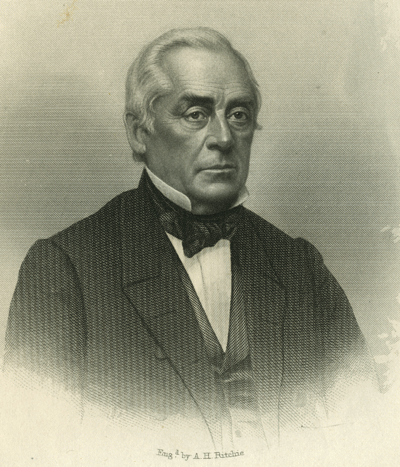
Hiland Hall is probably the most remarkable native son of North Bennington. Judge, congressman, governor, partriarch, chair of the California Land Commission during the Gold Rush, Hall also made his mark as an historian.
Below is a selection from a series of articles which Hall originally titled “Historical Readings.” It first appeared anonymously, sprinkled throughout the first weekly editions of the State Banner, published in Bennington in the spring of 1841.
Hall, then a veteran of ten years as a member of the U.S. House of Representatives, was among the paper’s founders. The State Banner served as a Whig alternative to the Democratic Vermont Gazette. In part, Hall was simply filling column space in the new journal.
Yet he clearly aspired to write a more complete Vermont history. After Hall had retired as governor, he expanded these “historical readings” into the 500-page Early History of Vermont, published in 1868.
In interpreting the dispute over the Vermont territory between New York and New Hampshire, Hall’s thesis was strongly anti-New York. He effectively contested the earlier pro-New York History of Eastern Vermont by Benjamin H. Hall (no relation.) Hall’s articles have been edited and re-titled Ruffian Democracy by Shaftsbury historian Tyler Resch.
In the selection below, Hall describes the famous standoff of the Green Mountain Boys with the New York sheriff at the Breakenridge Farm on Murphy Road, just outside North Bennington.
In obedience to the governor’s proclamation, Henry Ten Eyck, sheriff of Albany County, in company with John Munro and others, repaired to the house of Silas Robinson in Bennington, early on the morning of Nov. 29, and arrested him. They came upon him unexpectedly when he was alone, and by moving with great rapidity before notice could be given to his neighbors, they succeeded in carrying him to Albany.
The sheriff appears to have been greatly elated with his exploit, and immediately wrote to Governor Dunmore informing him of his successful expedition to Bennin035A13gton, at the same time telling him that from the advice of said Munro, and other information he received he judged it best to return with his prisoner (especially as he was reported to be one of the principal among them) rather than risk his being rescued
The governor wrote a complimentary letter to the sheriff, highly approving of his conduct, and directed him to hold his prisoner in custody until he should be released by due course of law. The governor also directed the King’s attorney general to prosecute Robinson for the matters charged against him.
At the January term, 1771, of the Albany Court of Sessions, Robinson was indicted as a rioter and was kept in confinement in the Albany jail until October following, when he was released on bail. Messrs. Hathaway, Scott and Fisk, before mentioned, and twelve others, were indicted with Robinson, but none of them was arrested.
From the time of the rendering of the judgments of ejectment at Albany up to the spring of 1771, various essays had been made by the sheriff to put the plaintiffs in peaceable possession of the premises, which had been adjudged them by the court, but without success. Whenever the sheriff came he was sure to be met by a party larger than he brought with him, and told that any attempt to execute a writ of possession would certainly be resisted with force. These ineffectual attempts of the sheriff being reported to the governor, he directed him to summon the posse, or in other words the militia of the county, to his aid. This was accordingly done early in the month of July 1771.
The following account of the expedition of the posse to Bennington is taken from Ira Allen’s history of Vermont, a work published in London in 1798, and which is now very scarce.
“The sheriff of Albany County summoned the posse to aid him in serving a writ of possession on James Breakenridge. The sheriff was followed by 750 men well armed, and 300 of the settlers assembled to resist him. The settlers had full notice of his approach and had completed their arrangements for defense. An officer with 18 men was placed in the house — 120 behind trees in a wood near the road, through which the sheriff must march and would naturally halt his men. The other division was stationed behind a ridge of land in a meadow, within gunshot of the house and out of sight of the sheriff’s men. Thus the ambuscade was formed to have a crossfire on the sheriff’s men without endangering themselves, and to be ready when the sheriff forced the door, which was to be known by hoisting a red flag above the top of the chimney.
“When the sheriff approached all were silent; he and his men were completely within the ambuscade before they discovered their situation. Sheriff Ten Eyck went to the house and demanded entrance as sheriff of the county of Albany, and threatened on refusal, to force the door; the answer was ‘attempt it, and you are a dead man.’ He repeated his demand and threat, without using any force; and received for a second answer hideous groans from those within! At this time the two divisions exhibited more numerous than they really were. The sheriff and his posse seeing their dangerous situation, and not being interested in the dispute, made a hasty retreat, so that a musket was not fired on the inhabitants, and raised their consequence in the neighboring colonies.”
Read a short biography of Hiland Hall by Tyler Resch (pdf)